Open-File Report 99-7-B
GEOTEM is a proprietary, fully digital airborne survey system developed and operated by Geoterrex, LTD, of Ottawa, Canada. CDTs (Conductivity Depth Transforms) are a proprietary product provided at extra cost by Geoterrex. These are calculated conductivity-vs-depth sections derived by mathematical transform of the 120-channel airborne electromagnetic in-phase/quadrature data acquired by the GEOTEM geophysical survey system, using an infinite half-space assumption. We compared the CDT sections first with Vertical Electrical Soundings (VES) carried out in the upper San Pedro Basin and reported in Pool (1998), and second with water-table depths (Tatlow, 1998) and with older well-logs. In general we found good agreement between the CDT information and the VES and well-logs for the first 150 meters below the Earth's surface. We also found good agreement between the CDTs and other sources of San Pedro Basin aquifer information [for instance, Corell et al., 1996). There is excellent correlation between CDTs and water-table depths. When there is a disagreement between the VES soundings and the CDT data, the water-table data support the CDT data. We conclude that the substantive interpretations and maps of the "San Pedro Basin Airborne EM Survey - Preliminary Report" (Wynn and Gettings, 1997) are valid.
In January 1997 the USGS contracted and supervised a time-domain Airborne ElectroMagnetic (AEM) and magnetic survey over the upper San Pedro River drainage, covering an area roughly 400 square km in size between Fort Huachuca and the San Pedro River in Cochise County, southeastern Arizona (see index map, figure 1.

A larger version of figure 1 can be obtained by clicking here).
Using an initial, informal release of raw data from the contractor (Geoterrex Ltd. of Ottawa, Canada), a Preliminary Report was produced for immediate use by the US Army Garrison at Fort Huachuca (Wynn and Gettings, 1997). In an effort to evaluate the final release of data (received by the USGS on 22 March 1998) in more detail, we have examined the airborne multi-channel conductivity map grids, the Conductivity Depth Transforms (CDTs), and the aeromagnetic map grid provided by Geoterrex, Ltd. We have focused our efforts primarily on two areas:
Note: in this report conductivities and resistivities are both used, depending on the data under consideration. Well-logs are almost always reported as resistivity vs. depth, whereas most AEM systems report conductivities. Resistivity is simply the inverse of conductivity: rho = 1/conductivity . We have tried throughout this report, whenever possible, to relate the electrical resistivity observed (or calculated in the case of the CDTs) to the lithology and porosity of the underlying rocks and unconsolidated sediments we are mapping.
The Geoterrex GEOTEM System is an airborne GEOphysical Time-domain ElectroMagnetic system comprised of an aircraft (in this case a Brazilian CASA Turboprop) and a set of closely integrated transmitter and receiver coils. The transmitter array consists of six horizontal-loop cables strung from nose to wing to tail to wing to nose on the outside of the aircraft - a total loop area of 232 square meters. This transmitter loop array is driven by a 935-amp (600 amps RMS), half-sine-wave time-domain signal, powered by a generator-transmitter located onboard the aircraft. The received signal (consisting of the primary transmitted signal and the secondary Earth-response signal) is measured by a towed-bird detector with three mutually perpendicular coil axes. The EM bird is towed behind and about 120 meters above the ground during flight. The three receiver-coil axes are sensitive to horizontal conductors (the z-axis), and vertical conductors (x- and y-axes). The x-axis receiver coil couples preferentially to signals arising from vertical conductors whose strike is parallel to the flight direction, while the y-axis responds preferentially to vertical conductors perpendicular to the flight direction. Since the survey was designed to search for water in horizontal and sub-horizontal layering, we focused our analysis on the secondary signal captured by the z-axis coil.
Survey flight lines are described in detail in Chapter 1 on the magnetic survey; the flight lines are shown in figure 2.
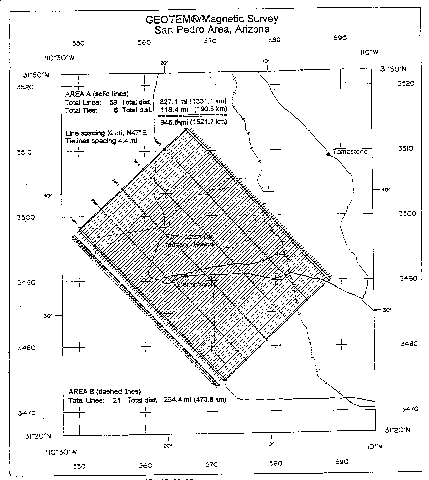
A higher-resolution version of Figure 2 can be obtained by clicking here.
For an EM dipole, signal strength falls off as the distance cubed, so it is essential to maintain the transmitter as close to the ground as safety permits. Effective signal penetration-depth also increases with decreasing frequency (which arrives at progressively later times after the initial impulse). Nominal flight (and therefor transmitter) terrain-clearance was thus held at 120 meters (400 ft) except where FAA regulations required 500 ft terrain-clearance over inhabited areas. The EM transmitter operated at the system minimum repetition rate of 30-Hz, giving a pulse width of 4036 /sec. this was done to maximize the penetration of the transmitted signal in an arid, conductive environment. The 3-component multicoil system at this repetition rate is expected to provide conductivity information as well as structural information about the upper 150-200 meters of the subsurface.
Real-time digital processing done on the received signal allows for the efficient removal of the primary signal and effects of aircraft frame flexure and vibration, a process called "compensation". The different time-sampling windows of the resulting residual Earth coupling response thus have a low noise content, which permits effective use of secondary signals from substantial depths. This "gating" also gives an indication of the depth of the source; that is, longer times correlate with deeper sources. The CDT calculation process, based on a forward-modeling signal-correlation algorithm, converts these gated results to discrete conductivities as a function of depth.
The following maps give resistivities derived from the z-axis receiver coil (the coil preferentially coupled into flat-lying conductors beneath the ground) at different times in the received decay signal. Channel 2 in these representations is the deepest-penetrating channel, while channel 10 is the shallowest represented shown here. Table 1 below shows the mean delay times in microseconds for each channel after the end of the half-sine transmitter pulse.
TABLE 1. Delays in microseconds for each EM channel in the Geoterrex GEOTEM airborne system.
| CHANNEL | Delay in microseconds |
| Channel 1 | 1106 |
| Channel 2 | 1432 |
| Channel 3 | 1822 |
| Channel 4 | 2278 |
| Channel 5 | 2864 |
| Channel 6 | 3580 |
| Channel 7 | 4427 |
| Channel 8 | 5403 |
| Channel 9 | 6510 |
| Channel 10 | 7877 |
| Channel 11 | 9569 |
| Channel 12 | 11523 |
| Channel 13 | 846 |
| Channel 14 | 586 |
| Channel 15 | 390 |
| Channel 16 | 260 |
| Channel 17 | -455 |
| Channel 18 | -1757 |
| Channel 19 | -3059 |
| Channel 20 | -3841 |
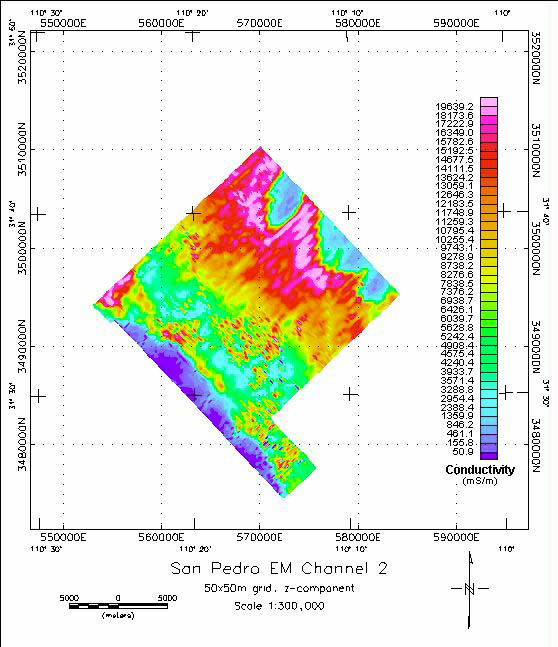 Figures 3 shows the conductivities for the z-axis coil for
the gated window designated as EM channel 2; this corresponds to the deepest penetration
signal. (A higher-resolution version of figure 3 can be seen by
clicking here.)
Figures 3 shows the conductivities for the z-axis coil for
the gated window designated as EM channel 2; this corresponds to the deepest penetration
signal. (A higher-resolution version of figure 3 can be seen by
clicking here.)
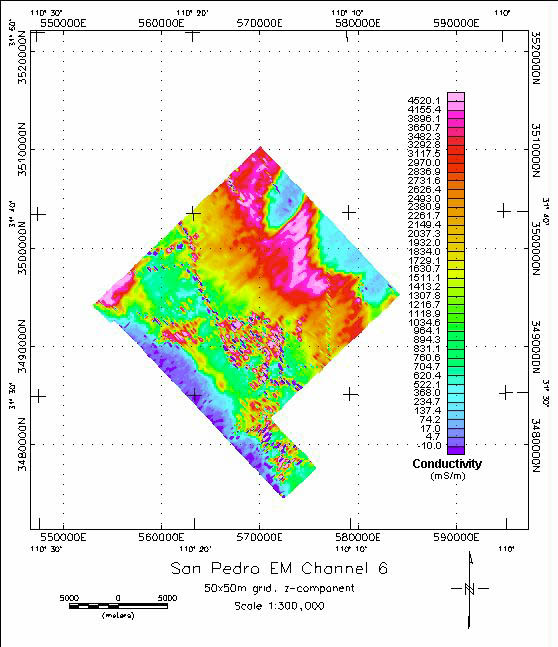
Figures 4 shows the conductivities for the z-axis coil at channel 6, representing an intermediate depth. (A higher-resolution version of figure 4 can be seen by clicking here.)
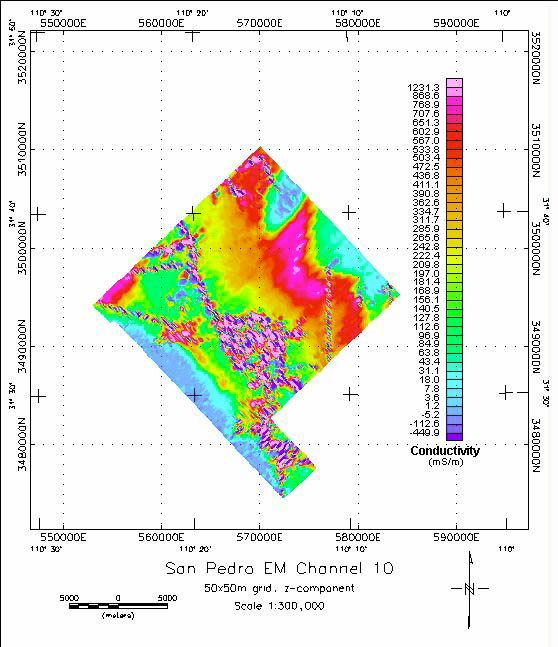 Figure 5 shows the conductivities for the z-axis coil for
channel10, the shallowest-penetrating channel reported by Geoterrex. Note the strong
cultural interference (high-frequency speckling) caused by electrical power lines at
Sierra Vista, Fort Huachuca, and along the connecting roads.(A
higher-resolution version of figure 5 can be seen by clicking here.)
Figure 5 shows the conductivities for the z-axis coil for
channel10, the shallowest-penetrating channel reported by Geoterrex. Note the strong
cultural interference (high-frequency speckling) caused by electrical power lines at
Sierra Vista, Fort Huachuca, and along the connecting roads.(A
higher-resolution version of figure 5 can be seen by clicking here.)
In effect, these figures can be roughly thought of as depth-slices in the 3-D conductivity of the survey area. Cultural interference is caused by pipelines and grounded powerlines, both of which strongly couple to the high-frequency signals of the AEM transmitter. In the channel 10 z-axis conductivities, Fort Huachuca and Sierra Vista are clearly outlined by this speckling; in the eastern side of the figure a north-south band of speckling apparently represents coupling to the metal structure of an aquaduct. Channel 2 has much less interference from human culture, but residual effects can still be seen even in this channel.
On all three figures, conductivity variations generally
reflect water content, which can be used to infer lithologic changes. This association can
be attributed principally to changes in porosity, since the conductivity of the ground
water is presumed to vary little in the San Pedro Basin. In fact, the source of
conductivity variations is not always quite as simple as this; sometimes significant
changes in the content of certain types of clays in the aquifer will also affect the
conductivities. Some of the differences noted later may be due to changes in clay content
as one moves away from the Huachuca Mountains. The southwestern edges of the images show
blue (low conductivities), corresponding to the low-porosity crystalline rocks of the
Huachuca Mountains. The centers of the figures are dominated by greens, yellows, and reds
(conductivities of 5,000 to 20,000 mS/m), generally reflecting the higher water-content of
the sediments in the basin. The northeastern parts of the figures are dominated by a
systematic variation in conductivities that reflect the presence or absence of exposed
rocks of the Tombstone Hills (the blue appearing at the upper right edges). It is clear
from these images that the crystalline rocks of the Tombstone Hills extend farther west
than shown on the geologic map; in other words, the sediments lap onto shallowly-buried
crystalline rocks, covering their western extent with a thin veneer of unconsolidated
sediments. Also in these figures, there is a systematic variation in the porosity/water
content of the sediments between Sierra Vista and the Tombstone Hills. This variation
shows increasing conductivity towards the northwest: this is interpreted as the water
table shallowing towards the northwest. This correlates exactly with the known behavior of
the water table from the few wells in the area, and verifies that these conductivity maps
effectively map the water table in three dimensions. A comparison of the red zones in the
channel 2 and the channel 10 data shows that the deeper-penetrating resistivity map
(channel 2) also shows abundant water closer to Sierra Vista... in other words the deeper
image picks up the deepening aquifer closer to the city as one moves farther southwest.
There are additional subtle offsets in the apparent
conductivities in figures 3-5 that are not directly related to the presence of the
Tombstone Hills or Huachuca Mountains crystalline rocks. One of these offsets exactly
coincides with the mapped location of the Sawmill Canyon Fault (Drewes, 1980). It is
reassuring that the AEM data not only agree with the water table (and apparently map it
with precision), but also apparently correlate well with other known geologic structures
in the area.
It is appropriate here to point out a fundamental difference between the electrical and magnetic datasets. Depth of penetration of AEM (active) systems is a function of distance from the transmitter, whereas depth of penetration for magnetic profiling (passive) systems is a function only of how long the profile is. The geometrical limitations of the GEOTEM system thus permit us to map only the top 150-200 meters of the ground, and with few exceptions cannot see below this, whereas the magnetic data allow us to map the local crystalline basement in some cases as deep as 1 km. The shallower EM data, however, offer us far more information and resolution in the top zones of the aquifer than the magnetic data, which conversely is our exclusive source of information for the deeper zones. Trying to compare the two would be a mistake... like comparing apples and oranges. Instead, the two different datasets compliment each other by providing much more information about different physical properties together than they could if only one or the other were used.
One final observational note should be made here. Recalling that the signal strength of an EM dipole falls off with distance cubed, one effect of the human cultural interference is to overload the dynamic range of the secondary Earth response in the receiver coils. In effect, the weakening-with-depth signal can be overwhelmed in some places by cultural noise. The CDT calculation process includes a data-quality test, and when the noise exceeds the signal, colors are cut off on the bottom of the CDT and the transformation stops calculating conductivity for depths any deeper than this. This is manifested on the CDTs (see Plates 3.1 to 3.4 in Chapter 3) as blackened-out transformations below certain, varying depths. Where the blackened part rises closer to the surface, it means that human cultural interference has overwhelmed the transformation in this area.
An up-to-date, edited file of water-table information was obtained from Maurice Tatlow of the Arizona Department of Water Resources (Tatlow, 1998; also see Appendix 1). These water table depths are gridded and plotted over the terrain in figure 6.
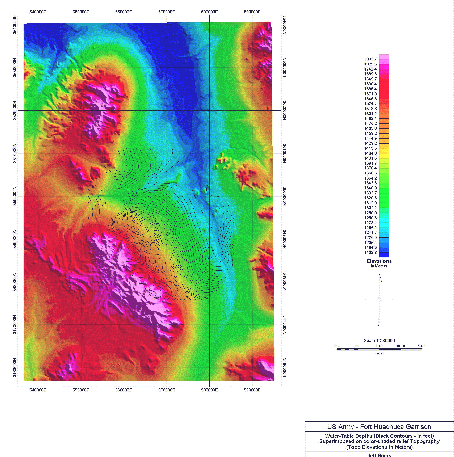
(A higher-resolution version of figure 6 can be seen by clicking here.) Most of these water-table records were narrowed down to the 1996-97 interval so they are most closely correlatable with the ground and airborne electrical data. These wells were geographically registered against the San Pedro Basin geology map (Kneale et al, 1997). Both of these data sources were geographically registered against the Geoterrex flight-lines for the San Pedro airborne EM and magnetic survey. A series of Schlumberger soundings (also known as Vertical Electrical Soundings, or VES) acquired by Pool (US Geological Survey, Water Resources Division Report, 1998) were also registered against the CDT, geology, and well data. This summary registration figure can be seen in Plate 1. Note that figure 6 (above) is a limited-data representation of the water table in the upper San Pedro Basin; figure 7 shows the locations of the VES soundings with respect to the geology and the well-locations
Figures 8-14 show comparisons between vertical CDT profiles, the VES inversions, and the water-table. Brief summaries of these comparisons follow in the table below. Each comparison figure showing CDT, VES inversion, and the water table can be seen by clicking on the appropriate link on the right side of the table. In this table "VES Station" refers to the name given by Pool (1998) to each location (figure 7) where the Schlumber sounding was carried out. "AEM Line" refers to the Geoterrex line number of the closest coincident flight-path, and "AEM Fid" refers to the fiducial, an arbitrary reference point along the line assigned by the Geoterrex data-processing software. The first two numbers of the fiducial refer to the Julian date in which the line was acquired.
| VES Station | AEM Line | AEM Fid | Comments | Figure |
| ALPHA1 | 126 | 59175 | The VES and CDT correlate well, with the final resistive basement being about 75 m shallower on the CDT than on the VES. The water table shows up at 30 m, just after the drop in resistivity begins on both curves. | 8 |
| BRAVO1 | 120 | 62200 | The VES and CDT vertical profiles correlate well, with only the CDT having a higher resistivity for the final basement (500 ohm-m plus) than the VES (about 100 ohm-m). The water table is located well into the low resistivity zone seen in the VES and CDT data, but still in the down-going side of the curves. | 9 |
| DELTA1 | 118 | 61175 | The VES and CDT soundings correlate only approximately, with the CDT showing final resistive basement at around 300 m depth and the VES showing only a slight increase in resistivity at 600 m. In the raw VES data however, the discrepancy is not surprising, since the deeper layers are very poorly resolved (though relatively noise-free). The water table is located on the down-going (decreasing resistivity) part of the CDT curve, but correlates poorly with the VES data. | 10 |
| FOXTROT2 | 129 | 57930 | Though the VES inversion and the CDT both show a high-low-high-low resistivity layering, the depths don't correlate well at all. Adjacent AEM lines were checked and they are the same, so the CDTs are self-consistent. The VES raw data only shows a single hump, low-over-high-over-low resistivity... e.g., we have an over-enthusiastic automatic inversion of the poorly-resolved layers, but also the CDT shows high-low-high-low-high (5 layers) with one high at the surface (dry gravels), a second coming in around 150 meters (low porosity or depleted zone), and the final resistive unit (the crystalline basement) coming in at 300-350 meters depth. The VES inversion process was never able to resolve the final resistive basement (the AB/2 spacing wasn't extended far enough, and the two conductors absorbed and channeled virtually all of the injected current). As shown in Chapter 3, the artificially high resistivities at depth are due to incorrect parameters set by Geoterrex in the CDT algorithm, something that can only be done accurately after a study such as this report is completed. The water table is close to the bottom of the down-going part of the CDT curve, but correlates poorly with anything in the VES data. | 11 |
| GAMMA | 113 | 59190 | There is only a very rough correlation between the VES and the CDT here. In part, this could be because it's hard to resolve the CDT image on the shallow end, but also the VES has some noisy offsets in the raw data. The VES data show a clear second conductor at depth that can also be seen in the CDT, but in the CDT it is deeper (180 m on the VES but 300+ m on the CDT). The water table lies again near the bottom of the down-going part of the CDT curve, but correlates poorly with the VES data. The second conductor is likely the deeper aquifer referred to in Pool (1998) and Corell and others (1996). It is satisfying to see such a complicated hydrologic model (Corell and others, 1996) verified at least in the CDT data. | 12 |
| GARDEN | 147 | 58120 | The correlation between the VES and the CDT is good here. The VES does not resolve the resistive basement seen clearly on the CDT, however. The water table lies about half-way down the down-going part of the CDT curve, right at the resistivity step-drop in the VES data. | 13 |
| HAVOC1 | 115 | 60035 | The VES and CDT data correlate exactly but again, the VES can't resolve the final resistive basement that is seen clearly on the vertical CDT profile. The water table lies near the bottom of the CDT resistivity low. | 14 |
The VES stations were acquired all over the upper San Pedro drainage where the AEM survey was flown, and are therefor a good sampling of the different parts of the San Pedro aquifer. One VES station acquired by Pool (1998) lies outside the bounds of the AEM survey (VES Station "BURN"), and could not be compared with the CDTs. On each figure we have placed an indication of where the water-table lies. These depths are derived from the closest nearby wells. As part of the comparison effort, the depth-to-water-table in the AEM survey area was also plotted using the Tatlow (1998) dataset (Appendix 1; See figure 6). The water table always lies somewhere on the down-going part of the CDT curve, generally between the half-way point and the bottom. It appears to be deeper in the down-going slope in the southwest-central side of the San Pedro basin. Where there is poor correlation between the VES data and the CDT curve, the water table always agrees well with the CDT data. The water-table coincides with the down-going portion of the CDT resistivity curve, almost certainly reflecting the fact that there is an unsaturated but wet vadose zone above the water table that is being picked up by the airborne system. On the basis of this examination, we could use the CDT data (but not the VES data) to draw the water table position to within at least 10 meters of its actual position. This would be highly useful in areas where there are no wells, such as nearby undeveloped basins, or in underdeveloped parts of the San Pedro Basin. One potentiail weakness of using electrical methods of any kind is the fact that there is generally poor contrast between saturated and unsaturated silt and clay.